
Size: 500 pieces
Dimensions: 38 cm x 52 cm
Producer: TOMAX, #61101
Notes: Angkor Wat is a temple complex at Angkor, Cambodia, built for the king Suryavarman II in the early 12th century as his state temple and capital city. As the best-preserved temple at the site, it is the only one to have remained a significant religious centre since its foundation – first Hindu, dedicated to the god Vishnu, then Buddhist. It is the world’s largest religious building. The temple is at the top of the high classical style of Khmer architecture. It has become a symbol of Cambodia, appearing on its national flag, and it is the country’s prime attraction for visitors. Angkor Wat combines two basic plans of Khmer temple architecture: the temple mountain and the later galleried temple, based on early South Indian Hindu architecture, with key features such as the Jagati. It is designed to represent Mount Meru, home of the devas in Hindu mythology: within a moat and an outer wall 3.6 kilometres (2.2 mi) long are three rectangular galleries, each raised above the next. At the centre of the temple stands a quincunx of towers. Unlike most Angkorian temples, Angkor Wat is oriented to the west; scholars are divided as to the significance of this. The temple is admired for the grandeur and harmony of the architecture, its extensive bas-reliefs and for the numerous devatas (guardian spirits) adorning its walls. [Wiki]
Tag: landscape
Puzzle: Taj Mahal Dreams by Walter Pepperle

Size: 1000 pieces, triptychon
Dimensions: 98cm x 37.5cm
Producer: Ravensburger, no. 19 990 7
Artist: Walter Pepperle
Box: Puzzles and Beyond
Notes: The Taj Mahal (from Persian/Urdu: “crown of buildings”) is a mausoleum located in Agra, India. It was built by Mughal emperor Shah Jahan in memory of his third wife, Mumtaz Mahal. It is widely considered as one of the most beautiful buildings in the world and stands as a symbol of eternal love.
Taj Mahal is the finest example of Mughal architecture, a style that combines elements from Persian, Islamic and Indian architectural styles.
Should guilty seek asylum here,
Like one pardoned, he becomes free from sin.
Should a sinner make his way to this mansion,
All his past sins are to be washed away.
The sight of this mansion creates sorrowing sighs;
And the sun and the moon shed tears from their eyes.
In this world this edifice has been made;
To display thereby the creator’s glory.
[Shah Jahan]
[Wiki]
Puzzle: Bay Bridge, San Francisco, U.S.A.

Size: 1000 pieces
Notes: The San Francisco – Oakland Bay Bridge (known locally as the Bay Bridge) is a pair of bridges spanning San Francisco Bay of California, in the United States. Forming part of Interstate 80 and of the direct road route between San Francisco and Oakland, it carries approximately 270,000 vehicles per day on its two decks. It has one of the longest spans in the world.
The toll bridge was conceived as early as the gold rush days, but construction did not begin until 1933. Designed by Charles H. Purcell, and built by American Bridge Company, it opened for traffic on November 12, 1936, six months before the Golden Gate Bridge. It originally carried automobile traffic on its upper deck, and trucks and trains on the lower, but after the closure of the Key System, the lower deck was converted to road traffic as well. [Wiki]
I do not have a record of the producer of the puzzle as I do not have the box anymore. A clarification is welcome – if you have any clue as to the details regarding this puzzle, I would much appreciate that information.
Photo: Golden Arches, April 22, 2011
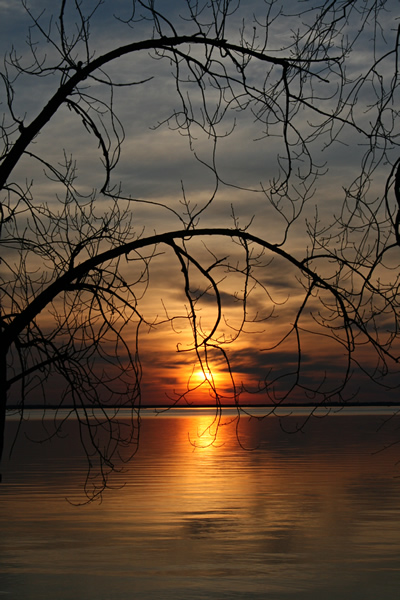
Photo: Sun Centered, April 22, 2011

Photo: Sunset Horizon, April 22, 2011

Photo: Tree in Golden Light, April 22, 2011

Puzzle: Niagara Falls, U.S.A.
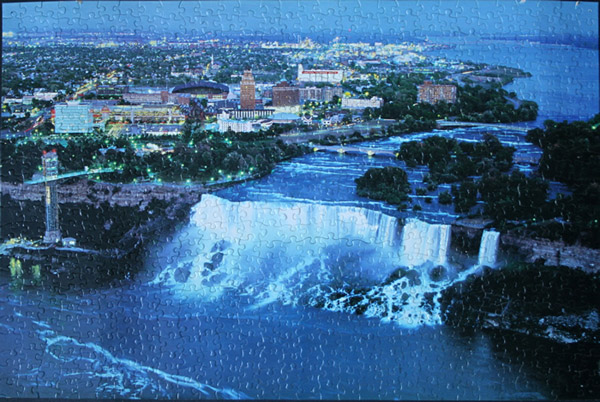
Size: 750 pieces
Dimensions: 59.7 cm x 39.4 cm
Producer: Sure-Lox
Notes: The Niagara Falls are waterfalls in North America. These voluminous waterfalls are situated on the Niagara River, straddling the international border between the Canadian province of Ontario and the U.S. state of New York. The falls are 27 km north-northwest of Buffalo, New York and 121 km south-southeast of Toronto, Ontario, between the twin cities of Niagara Falls, Ontario, and Niagara Falls, New York.
Niagara Falls is composed of two major sections separated by Goat Island: the Horseshoe Falls on the Canadian side and the American Falls on the American side. The smaller Bridal Veil Falls are also located on the American side, separated from the main falls by Luna Island. Niagara Falls were formed when glaciers receded at the end of the Wisconsin glaciation (the last ice age), and water from the newly formed Great Lakes carved a path through the Niagara Escarpment en route to the Atlantic Ocean. [Wiki]
Photo: Sunset Arch, April 22, 2011

Photo: Golden River, Dipping Branches, April 22, 2011

Puzzle: Vatican, Italy

Size: 500 pieces
Dimensions: 48.4 cm x 35.5 cm
Producer: Sure-Lox
Notes: Vatican City or Vatican City State is a landlocked sovereign city-state whose territory consists of a walled enclave within the city of Rome, Italy. It has an area of approximately 110 acres, and a population of just over 800.
Vatican City was established in 1929 by the Lateran Treaty, signed by Cardinal Secretary of State Pietro Gasparri, on behalf of the Holy See and by Prime Minister Benito Mussolini on behalf of the Kingdom of Italy. Vatican City State is distinct from the Holy See, which dates back to early Christianity and is the main episcopal see of 1.2 billion Latin and Eastern Catholic adherents around the globe. Ordinances of Vatican City are published in Italian; official documents of the Holy See are issued mainly in Latin. The two entities even have distinct passports: the Holy See, not being a country, issues only diplomatic and service passports; Vatican City State issues normal passports. Very few passports are issued by either authority.
The Lateran Treaty in 1929, which brought the city-state into existence, spoke of it as a new creation (Preamble and Article III), not as a vestige of the much larger Papal States (756-1870) that had previously encompassed much of central Italy. Most of this territory was absorbed into the Kingdom of Italy in 1860, and the final portion, namely the city of Rome with Lazio, ten years later, in 1870. [Wiki]
Puzzle: House in Wales
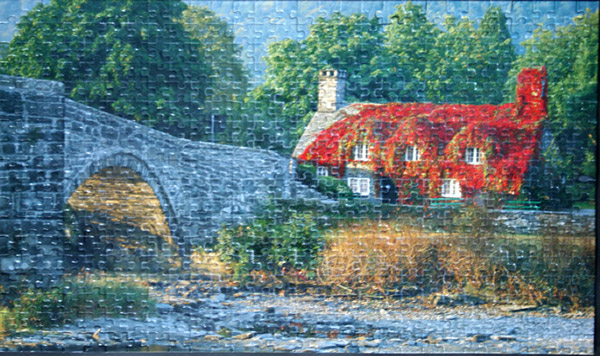
Size: 500 pieces
Notes: Not depicted on the puzzle, Simon Dale has built a house fit for hobbits in Wales. “Some of the characteristics of the wooden house are that it’s dug inside a hillside for shelter, lime plaster and mud are used to keep the walls sticking together, straw balls are used in floor, roof and walls, solar panels are installed for lightning, music and computers, and skylight on the roof gives natural light.” There are a few photos on the site, and it does look like a fairy tale dwelling. [Planet Oddity site]
I do not have a record of the producer of the puzzle as I do not have the box anymore. A clarification is welcome – if you have any clue as to the details regarding this puzzle, I would much appreciate that information.
Puzzle: Taste of Tuscany, Cucina Allegra
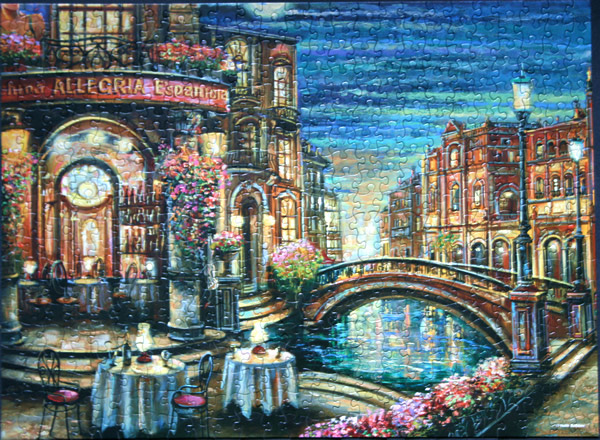
Size: 500 pieces
Dimensions: 48.26cm x 35.56cm
Producer: The Canadian Group, Sure-Lox, Taste of Tuscany series
Notes: “Cucina allegra” according to Google translates to “Happy kitchen”. If anyone speaks Italian, please correct this if it is wrong.
As I could not find anything online with this name, I assume it is the artistic description of the painting. And so, I found a site in the UK called “Happy Kitchen” and browsed around. It seems, the kitchen is ran by two women making wheat-free, sugar-free, dairy-free organic dishes. Would be interesting to try, although I could not tell from their contact page where they are based. [Happy Kitchen site]
Puzzle: Taste of Tuscany, Bella Piazza
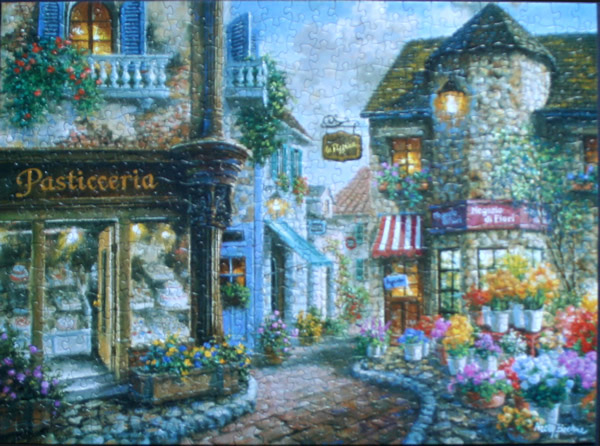
Size: 500 pieces
Dimensions: 48.26cm x 35.56cm
Producer: The Canadian Group, Sure-Lox, Taste of Tuscany series
Notes: A piazza is a city square in Italy, Malta, along the Dalmatian coast and in surrounding regions. The term is roughly equivalent to the Spanish plaza. In Ethiopia, it is used to refer to a part of a city. [Wiki]
Plaza is a Spanish word related to “field” which describes an open urban public space, such as a city square.[1] All through Spanish America, the plaza mayor of each center of administration held three closely related institutions: the cathedral, the cabildo or administrative center, which might be incorporated in a wing of a governor’s palace, and the audiencia or law court. The plaza might be large enough to serve as a military parade ground. At times of crisis or fiesta, it was the space where a large crowd might gather. Like the Italian piazza, the plaza remains a center of community life that is only equaled by the market-place. [Wiki]
Puzzle: Rustic home

Size: 500 pieces
Dimensions: 40.64cm x 40.64cm
Producer: Hasbro, MB Puzzle
Notes: rus·tic
–adjective
1. of, pertaining to, or living in the country, as distinguished from towns or cities; rural.
2. simple, artless, or unsophisticated.
3. uncouth, rude, or boorish.
4. made of roughly dressed limbs or roots of trees, as garden seats.
5. (of stonework) having the surfaces rough or irregular and the joints sunken or beveled. [Dictionary.com]
Puzzle: Lighthouse Scene by Wendy Schaefer-Miles and Kevin D. Miles
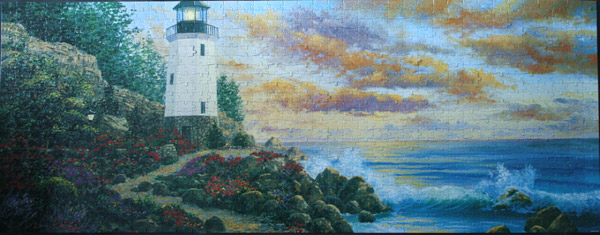
Size: 1000 pieces
Dimensions: 99.06 cm wide
Producer: Panorific, Sure-Lox
Artists: Wendy Schaefer-Miles and Kevin D. Miles
Box: photo
Notes: A lighthouse is a tower, building, or other type of structure designed to emit light from a system of lamps and lenses or, in older times, from a fire, and used as an aid to navigation for pilots at sea or on inland waterways.
Lighthouses are used to mark dangerous coastlines, hazardous shoals and reefs, and safe entries to harbors, and can also assist in aerial navigation. Once widely used, the number of operational lighthouses has declined due to the expense of maintenance and replacement by modern electronic navigational aids. [Wiki]
Puzzle: Japanese House
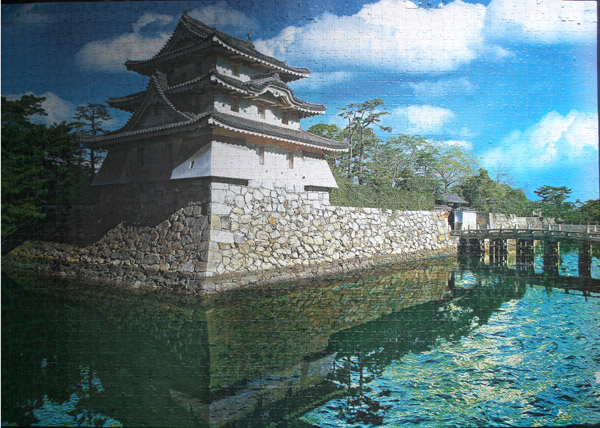
Size: 2000 pieces
Notes: Japanese architecture has a long history much like any other aspect of Japanese culture. Originally heavily influenced by Chinese architecture from the Tang Dynasty, it has also developed many unique differences and aspects indigenous to Japan as a result of dynamic changes throughout its long history. [Wiki]
A pagoda is the general term in the English language for a tiered tower with multiple eaves common in China, Japan, Korea, Vietnam, Nepal and other parts of Asia. Some pagodas are used as Taoist houses of worship. Most pagodas were built to have a religious function, most commonly Buddhist, and were often located in or near temples. This term may refer to other religious structures in some countries. [Wiki]
I brought this puzzle from Russia in 2007. The picture on the box differs from that on the puzzle – the clouds present in the puzzle are shown on the box as blue-purple gradient of the clear sky, and the water reflection differs accordingly.
I do not have a record of the producer of the puzzle as I do not have the box anymore. A clarification is welcome – if you have any clue as to the details regarding this puzzle, I would much appreciate that information.
Puzzle: Venice
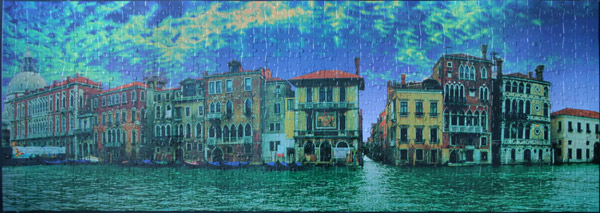
Size: 750 pieces
Dimensions: 86.36cm x 30.48cm
Producer: The Canadian Group, Sure-Lox, Panorific series
Notes: Venice (Italian: Venezia) is a city in northern Italy known both for tourism and for industry, and is the capital of the region Veneto, with a population of about 270,660 (census estimate 30 April 2009).
The name is derived from the ancient people of Veneti that inhabited the region as of 10th century B.C. The city historically was the capital of the Venetian Republic. Venice has been known as the “La Dominante”, “Serenissima”, “Queen of the Adriatic”, “City of Water”, “City of Masks”, “City of Bridges”, “The Floating City”, and “City of Canals”. Luigi Barzini, writing in The New York Times, described it as “undoubtedly the most beautiful city built by man”.
The city stretches across 117 small islands in the marshy Venetian Lagoon along the Adriatic Sea in northeast Italy. The saltwater lagoon stretches along the shoreline between the mouths of the Po (south) and the Piave (north) Rivers. [Wiki]
Puzzle: Manicured Gardens, San Diego
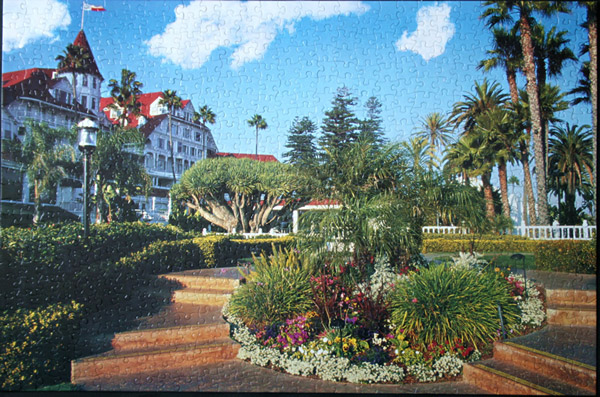
Size: 750 pieces
Dimensions: 39cm x 60cm
Producer: Impressions, Sure-lox
Notes: San Diego, named after Saint Didacus (Spanish: Diego de Alcalá), is the eighth-largest city in the United States and second-largest city in California, after Los Angeles, with a population of 1,307,402 (2010 Census) within its administrative limits on a land area of 963.7 km2. The city is located on the coast of the Pacific Ocean in Southern California. The urban area of San Diego extends beyond the administrative city limits with a population of 2,880,000, making it the third-largest urban area in California. San Diego is the 33rd richest city in the world. [Wiki]
Puzzle: Normandy Harbour

Size: 500 pieces, 1 missing
Producer: Puzzle World
Notes: Normandy (French: Normandie, Norman: Nourmaundie, from Old French Normanz, plural of Normand, originally from the word for “northman” in several Scandinavian languages) is a geographical region corresponding to the former Duchy of Normandy. It is situated along the English Channel coast of Northern France between Brittany (to the west) and Picardy (to the east) and comprises territory in northern France and the Channel Islands. The continental territory covers 30,627 km² and forms the preponderant part of Normandy and roughly 5% of the territory of France.
Parts of Normandy consist of rolling countryside typified by pasture for dairy cattle and apple orchards. A wide range of dairy products are produced and exported. Norman cheeses include Camembert, Livarot, Pont l’Évêque, Brillat-Savarin, Neufchâtel, Petit Suisse and Boursin. Normandy butter and Normandy cream are lavishly used in gastronomic specialties.
Normandy is a major cider-producing region (very little wine is produced). Perry is also produced, but in less significant quantities. Apple brandy, of which the most famous variety is calvados, is also popular. The mealtime trou normand, or “Norman hole”, is a pause between meal courses in which diners partake of a glassful of calvados in order to improve the appetite and make room for the next course, and this is still observed in many homes and restaurants. [Wiki]





